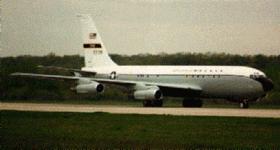


Flying Infrared Signature Technology Aircraft (FISTA)
Advanced weapon system designers and operational forces require calibrated IR databases and models of infrared signatures of targets, backgrounds, and effects of the natural and disturbed environment. The FISTA program has provided a large volume of spectral, spatial, and temporal data on aircraft, missiles, many surface targets, and extensive background measurements. Analysis for measurements are made in direct support of, but not limited to, operational programs from the National Air Intelligence Center (NAIC), Air Combat Command (ACC), Air Mobility Command (AMC), Air Force Information Warfare Center (AFIWC), Air Force Electronic Warfare Evaluation System (AFEWES), the F-22 SPO and other operational commands.
The Flying Infrared Signature Technology Aircraft (FISTA) program began in
1961 and first examined the infrared properties of the radiation from atmospheric
nuclear blasts and related night sky and auroral phenomena. When this requirement
ended with the signing of the nuclear atmospheric test ban treaty, in 1974 FISTA turned to measuring and understanding the infrared characteristics of aircraft and the
detection and identification of aircraft in the infrared range from atmospheric and
space-based platforms. This data was also used as the basis for the development of the Spectral and Inband Radiometric Imaging of Targets and Scenes (SPIRITS) database. This work is presently being done for the Air Force Research Laboratory (AFRL) by Utah State University, Stewart Radiance Laboratory.
With data obtained through the program, the FISTA team
at the Air Force Research Laboratory Space Vehicles Directorate at Hanscom Air
Force Base, Massachusetts, was able to develop methods of characterizing and
predicting the behavior of paint on signature characteristics of aircraft through
infrared computer models.
Although FISTA I was decommissioned in September of 1993 after 32 years of
service, its FISTA measurement capability was successfully transitioned to a new
NKC-135E aircraft. FISTA II completed its initial test flight on May 11, 1995. In
addition to certifying that the facility was operational, the FISTA team collected
some new data on the F-16. The Space Vehicles Directorate is again able to
support ongoing research in low-observable technologies such as those used on the
B-2 and F-117 programs and to provide infrared specification compliance of new
aircraft such as the F-22. Polarization properties of clouds to support clutter
suppression for scenes observed from space is also being measured.
The upgraded FISTA II sensors -- consisting of three imagers, three spectral
sensors, and a dual channel radiometer -- provide coverage over all infrared
wavelengths of interest. Multiple video and film cameras supply background,
aspect, and ranging information and the documentation necessary to decipher and
calibrate the data accurately. FISTA II has been designed so that all of its windows
can support the use of any of its sensors, allowing customized configuration.
FISTA II provides an improved capability to determine infrared signatures of
aircraft and other targets of interest to DoD. It also makes possible the testing of
new design techniques and low-observable coatings to assess their effectiveness.
This allows the Air Force to design aircraft with the lowest-observable infrared
signature. Further upgrades to FISTA II capabilities are in progress. A new,
calibrated visible imager has been developed, and new digital recording systems
will give existing and new infrared imagers increased resolution and sensitivity.
Measurements from FISTA are used extensively to verify and validate DoD
signature codes such as SPIRITS (Spectral and Inband Radiometric Imaging of
Targets and Scenes).

Sources and Methods
http://www.fas.org/irp/program/collect/fista.htm
Created by John Pike
Maintained by Steven Aftergood
Updated Wednesday, November 25, 1998 5:30:26 PM






